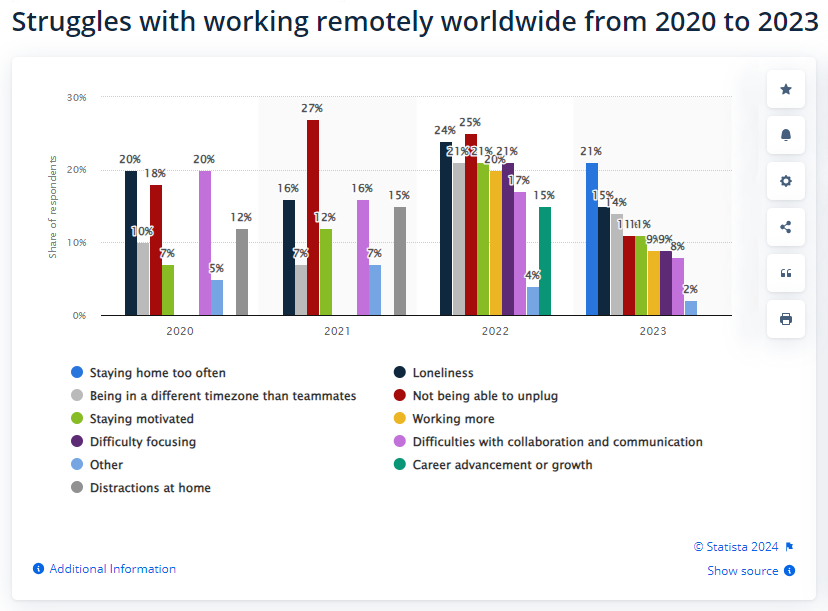The remote working trend is not something new. These days, we know (and maybe we are some of them) a lot of people working remotely, from home, coworking spaces, or cafes. If comfortable, you get more work-life balance, save time on commuting, and work for a company on the other side of the world. But is it that easy?
Let’s take a look at some unbelievable statistics that will make you rethink the remote work market. Learn about the benefits, real-life struggles, degrees, educational levels of remote workers, and much more!
Time Saved on Commuting
The first thing that makes people prefer remote work is the reason they live far from the workplace. Remote work can save a lot of time for employees around the world. Research by Statistics Canada shows that many remote workers save time previously spent commuting. Although this specific Canadian study doesn’t list a minute-by-minute comparison, it suggests that about 40% of jobs in Canada can be done remotely, which reduces commuting costs and time. All around the world, the average is 72 minutes. Sounds unbelievable, right?
Real-Life Struggles
Surely, besides benefits, remote work has several drawbacks that can be unsuitable for many people. Let’s take a look at Statista’s research. For 21 percent of the survey respondents, the biggest disadvantage of remote work is staying home too often. As they work mainly from home, they don’t have a reason to leave for work. Besides, a lot of people don’t have a special workplace at home, which can be uncomfortable.
Another reason mentioned by 15 percent of respondents is loneliness. Workplaces help people to socialize and feel connected with others. Many people think that working remotely can make one feel isolated from the team. Employees miss out on social interaction and don’t feel the office environment and values. That’s why a number of companies have started to incorporate video creation into their HRM practices. This way, remote workers can feel connected and share their ideas.
Other disadvantages are difficulty focusing, being in different time zones than teammates, and working more.

Percentage of Employees from 2015 to 2023
We all know that working remotely is very popular these days. But do you know the percentage of people working from home? The trend of remote work started in 2015, but with Covid-19 in 2020, everything has changed. According to Statista, by 2023, in tech, there were 67% of employees working remotely (fully or mostly). More than half of the workers in the tech sector worldwide prefer remote work! It all comes with the flexibility of tech organizations with remote vacancies, as they will get reduced costs, increased productivity, and international employees.
Increasing Numbers of Workers in Canada
A report by Statistics Canada projects a continuing increase in remote work across industries, driven by advancements in digital technology, as seen after the pandemic forced many businesses to adopt remote working.
This trend indicates that companies are likely to continue offering flexible work options. As remote work becomes more common, it can lead to better work-life balance and higher job satisfaction for many employees. Overall, remote work is expected to grow, shaping the way we think about jobs and workplaces in the future.
Degree and Education Level
In Canada, as in other countries, a higher education level increases the likelihood of being able to work remotely. People with a bachelor’s degree or higher are more likely to work remotely compared to those without a postsecondary degree.
In addition to formal degrees, many people are turning to online programs to enhance their skills and enter the remote job market. Institutions like ABM College offer career-focused programs that prepare individuals with the skills today’s employers are looking for. These programs cover in-demand fields such as business, healthcare, law, and technology, offering both classroom and fully online options, allowing students to complete their education from anywhere.
Remote learning opportunities make it easier to gain relevant qualifications while balancing other commitments. With flexible scheduling options, including day, evening, and weekend classes, learners can find a program that fits their lifestyle. Online programs also provide real-world practice through practicums, allowing students to build practical experience remotely.
Top Remote Jobs in 2024
Of course, several industries and jobs are more popular for remote work than others. One of the most popular industries is IT. The reason is that work itself is digital and only needs a steady connection to the internet. Other common industries include marketing, accounting, finance, project management, sales, customer service, administrative sphere, and more.
What about the most common job postings? By 2023, the first place took the accountant vacancy. This shows that a number of traditional jobs are becoming remote. Also, financial analyst, project manager, customer support representative, software engineer, writer, and product designer were also on the list of top vacancy posts.
Conclusion
The popularity and rise of remote work changed the global job market and brought a number of pros and cons. According to statistics, employees can now have a more flexible work-life balance, enter international companies, and save a lot of time. However, remote workers also experience drawbacks, like feelings of loneliness, a lack of socialization, and challenges with collaboration.
Knowing the pros and cons, statistics, and changes in the remote work industry will make it easier for job seekers to understand what they are looking for.
Contact us to learn more.
Read more trending blogs.
About The Author

Private Career College
ABM College is a leader in career-focused education, committed to empowering students with industry-relevant skills. With expert instructors and practical training, ABM College delivers high-quality programs in health, business, technology, and more, ensuring graduates are prepared to meet workforce demands. Known for its supportive learning environment and a focus on real-world application, ABM College is a trusted educational partner helping students achieve professional success across Canada.
